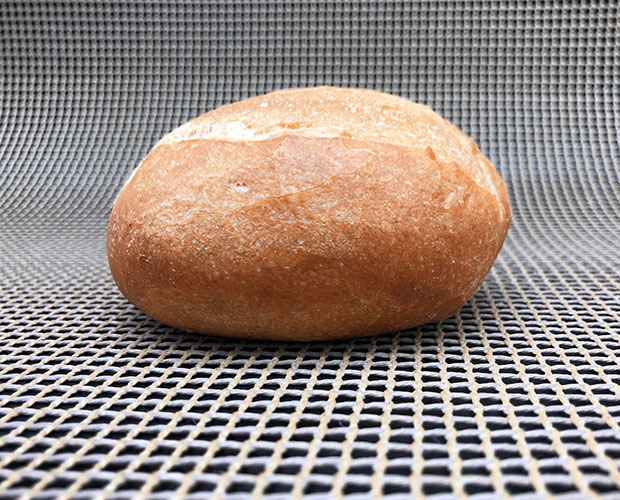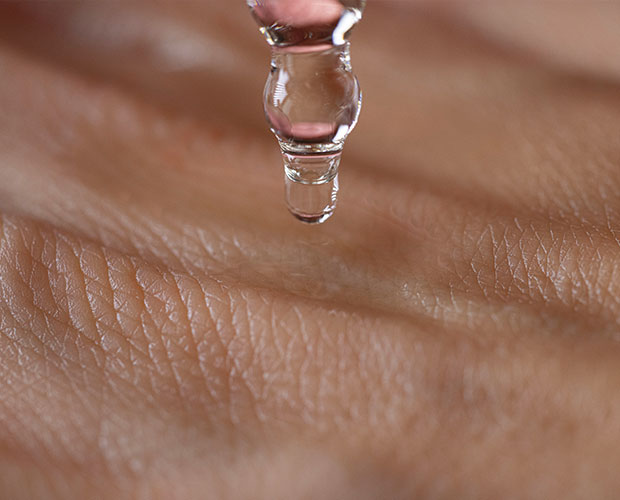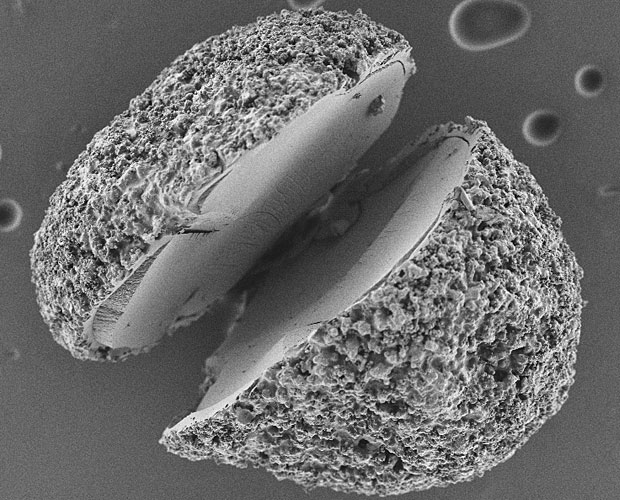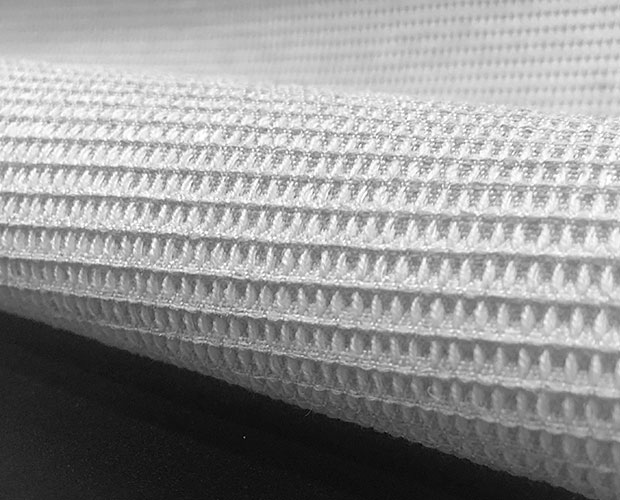Sustainable research − research for sustainable future products, this encompasses many other areas of business.
For example, more environmentally friendly delivery forms of fertilizer materials for agriculture can help avoid microplastics in fertilizers. New aids for food production can also help save resources in the production of baked goods, for example, and produce in a more environmentally friendly way. And even evidence-based cosmetics development, which studies the actual effect of plant oils on skin cells, pays dividends in terms of more sustainable products. You can read exciting examples of this in the following projects.
Research for people and environment
Examples from current research
Project "BakeTex"
"BakeTex": textile baking mats

Textile products are light and flexible. Consequently, they are becoming an increasingly attractive option for industries and the bakery industry is an example of one sector which has recognized the potential of these products when it comes to saving energy and resources. The BakeTex project is working on the development of a textile baking mat that can be used as an alternative to conventional baking trays.
The aim of this project is to create a baking mat for use in commercial bakeries that is free from harmful substances, saves energy, and that can be washed and re-used many times. Temperature-resistant, lightweight textiles heat up quickly and thus have the potential to reduce oven preheating temperatures and lower energy consumption. These innovative textile baking mats constitute a resource-saving and reusable alternative to baking paper. They generate potential energy savings and are light-weight and highly flexible, making them an attractive choice for bakeries.
The textile baking mat is foldable, therefore saving storage space. In order to assess the baking mat’s influence on the product and oven, baking tests are being carried out and the temperature curve is being measured. Initial stages of the project focused on identifying suitable fiber materials and developing a weave. Then, work was carried out on a coating for the baking mat that could prevent baked goods from sticking to the mat. Future stages of the project will see the development of a lightweight frame construction for stretching the material and, finally, the project will focus on individual branding and tracking within the bakery by means of RFID chips or QR codes.
Further information
Collaboration Kneipp GmbH
Studying the effect of plant oils on 3D skin models
Collaboration with Kneipp GmbH, Würzburg

Back to nature: the use of plant oils in natural cosmetics
Skin care has been around since ancient times. The ancient Greeks used natural active ingredients in plant oils such as olive oil to care for their skin. In modern times, these vegetable oils have been replaced by refined mineral oils, which although less expensive, also pollute the environment. Recently, we have witnessed an increased social awareness surrounding resource conservation and natural products. This has also impacted the cosmetics industry where we can see a return to plant-based, natural substances that is curbing the use of refined mineral oils.

Systematic investigation of natural oils
Whilst the fact that vegetable oils can have positive effects on skin is no new discovery, to date, no systematic investigation into the different effects generated by different natural oils has been carried out. To remedy this, the Fraunhofer Translational Center for Regenerative Therapies at the Fraunhofer Institute for Silicate Research has decided to develop a systematic testing method for different natural oils to help identify what impact they have on the skin and subsequently facilitate their use in the cosmetics industry.
The aim of the project is to create a fact sheet for up to 100 natural oils. These will be tested for their general, protective, and regenerative effects. In vitro skin models will serve as the basis for the testing which involves using a modular system to recreate different skin types with different properties. In vitro skin models for both healthy skin and damaged skin (in the sense of cosmetic damage such as damage caused by aggressive hand washing) are being used. The oils are then applied to the different skin models and analyzed by means of a specific testing procedure in order to identify their general, protective, and regenerative effects.
After testing 13 oils, the research team came to an important conclusion: there are serious differences in the effects that the oils have on the skin. Natural oils not only have a positive effect on the skin but can also have negative effects under certain circumstances.
Project "HybridPEARLS"
"HybridPEARLS":
Functional encapsulation through multiple coating

Environmental pollution is one of the major global problems of our time. One cause of this pollution comes from microplastics which end up in the soil and in oceans via wastewater. The European Chemicals Agency defines microplastics as small particles formed during the decomposition of macroplastics contained in cosmetics or agrochemicals. In particular, encapsulations of active ingredients, usually made of synthetic polymers and found in fertilizers, pesticides, and cleaning products, break down into microplastics and enter the environment. Whilst the function of these encapsulations is essential for everyday life as well as for agriculture and industry, in the long run, they cause significant damage.
bioORMOCER® as a coating material for active ingredient carriers
Given the impact of these microplastics, Fraunhofer IAP and Fraunhofer ISC are working to find replacements for synthetic polymer coatings. The material must, on the one hand, have very good application properties in terms of chemical and thermal stability, barrier properties, and storage stability, and, on the other hand, be fully biodegradable under natural environmental conditions. The search for a material that fulfils both these requirements has led to a functional barrier coating material developed by Fraunhofer ISC – bioORMOCER® coatings.
The HybridPearls project aims to establish a functional encapsulation by means of multiple coatings. These coatings must exhibit improved application properties compared to the current state of the art and must be able to break down completely. The structure is to be based on commercially applied encapsulation techniques already used in the production of packaging materials. Microcapsules of this type ultimately consist of three components: (1) the active ingredient core, (2) the biodegradable capsule material, and (3) the functional biodegradable barrier layer – the bioORMOCER®.
In the first subproject, Fraunhofer ISC has set out a number of research areas related to bioORMOCER® and the coating processes. An important requirement for the bioORMOCER® coatings is their ability to adapt to different areas of application. The development of tailor-made bioORMOCER® coatings should enable a modular system that promises variability (e.g., with regard to the encapsulated materials and their controlled degradation) and versatility with a wide range of applications in areas such as in agriculture and industry. To successfully produce the capsules, the active ingredient carriers and production processes must be coordinated with each other.
Homogeneous coatings, low layer application, and layer abrasion are essential criteria within the manufacturing processes. Accordingly, the HybridPeals project is working on developing and testing suitable coating technologies.
Further information
Project "Safe Vulca"
"Safe Vulca": Increasing efficiency in rubber vulcanization

Vulcanization is an important process in tire production in which rubber is converted into an elastomer. ZnO, currently the most efficient vulcanization activator, is used in this process to improve and control the reaction rate. However, ZnO poses potential environmental risks that cannot be ignored: According to the U.S. Environmental Protection Agency (EPA), zinc ions can be released from zinc oxide through various mechanisms, and zinc ions are expected to be toxic to aquatic organisms. Therefore, reducing ZnO content in elastomers is a global challenge, especially in tire manufacturing. In addition, large amounts of ZnO also make it difficult to recycle used tires.
The "Safe Vulca" project, funded by EIT RawMaterials, aims to reduce the amount of conventionally used microcrystalline ZnO activator while improving the efficiency of the crosslinking process by replacing ZnO with a novel bifunctional filler ZnO-NP@SiO2-NP.
The idea is to anchor amorphous ZnO nanoparticles on the surface of the silica reinforcing fillers and thus achieve a more homogeneous distribution throughout the rubber matrix compared to microcrystalline ZnO. This leads to an increase in reactivity and, consequently, to an increase in efficiency during rubber vulcanization. The bifunctional filler is produced via an easily scalable and environmentally friendly sol-gel process. This specific process has already been validated for the successful production of elastomer composites with high mechanical performance using ZnO-NP@SiO2-NP in conventional tires.
The substitution of crystalline ZnO activator with ZnO-NP@SiO2-NP leads to remarkable vulcanization efficiency, as the dispersed zinc nuclei can react with the vulcanizing agents in the rubber matrix during vulcanization. This enables a reduction of the conventional amount of ZnO by about 50 % and the production of rubber composites for tire applications with up to 10 % better vulcanization and mechanical properties than with the conventional activator.
The Fraunhofer ISC's "Particle Technology" group was responsible for upscaling the wet chemical synthesis and the accompanying characterization for quality assurance. In this way, the "Save Vulca" project was able to take the decisive step from the gram to the kilogram scale in the production of the bifunctional filler. Particularly important for cost-effective and environmentally friendly production on a larger scale is the conversion of the synthesis route from an ethanol-based to a water-based system. The ISC team made this conversion possible thanks to its extensive synthesis expertise. In the process, it was also possible to increase the synthesis yield and improve the overall scaling potential.
